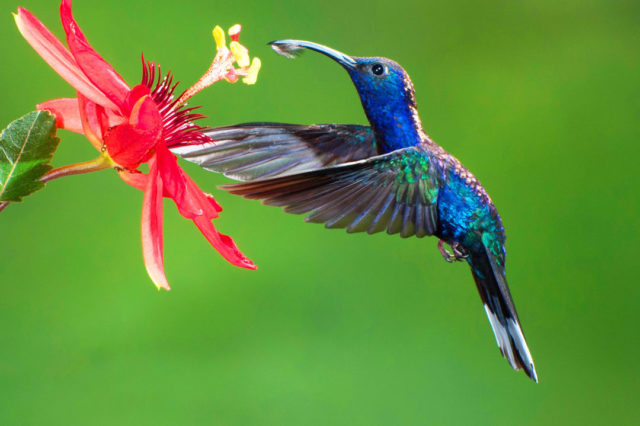A blue heron is seen among the vegetation of Tortuguero National Park, on January 29th, 2022. A jacana is seen flying in the mangroves of Tortuguero National Park, on January 29th, 2022.
The Caribbean of Costa Rica is filled with a colorful migration of birds considered the most important in the country and key in America, which is why its conservation and protection is essential. Currently, the work for the sustainable development of all areas, especially tourism, is significant, much more so if we focus on bird watching, which is ideal for Costa Rican or foreign citizens.

Costa Rica is one of the 5 places in the world with a migration of approximately 3 million birds of prey per season, in which Keköldi (Caribbean) is included as a preferred site. The good tropical climate that Costa Rica has and the strategic location between North and South America means that in some months of the year numerous species of birds can be appreciated.
Between the months of August and November, people can observe the millions of birds of prey, comprised of 17 species, on the Atlantic coast. In Costa Rica, people can see up to 100 species of birds in a single day.
Specific dates
Costa Rica, has 51,100 square kilometers of land area (0.03% of the world’s surface), is home to approximately 5% of global biodiversity and a total of 925 bird species, more than 9% of the birds in the world. It is noteworthy that the geographical location of Costa Rica has allowed it to be a biological bridge, especially in the autumn migration (August to December) from North America to South America and then the birds return to North America in their spring migration (February to May).
According to the representative of the Costa Rican Tourism Institute (ICT), Rafael Soto, between 2017 and 2019, 64.8% of tourists had ecotourism as their main activity and, of these, 12.3% observed birds with special equipment. And speaking of the ICT, a few months ago it became known that the institute organized the 5th annual bird count in the Tortuguero National Park located in the Caribbean, there more than 40 experts recorded the number of birds they observe in one day; the purpose of the activity is to unite efforts to strengthen birdwatching and, in turn, protect the species.

Only Tortuguero National Park has 366 registered species, species such as the crested eagle, considered the second largest eagle in Costa Rica and difficult to see. It is more than clear that for the authorities, bird watching represents one of the activities that is constantly developing and allows travelers to live a unique experience without having to travel long distances.
Some curiosities about migratory species
Central America is important for bird migration, because its territory acts as a bridge. A large number of bird species that winter in South America pass through Costa Rica instead of making the dangerous journey over open water in the Caribbean Sea. By flying over the ocean, birds not only run the risk of becoming exhausted and falling into the water, but they can also fall prey to falcons following their same migratory route.
Despite the obstacles, some species do travel over the Caribbean, flying at night and stopping from island to island during their migration. According to the Cornell University Laboratory of Ornithology, more than 300 types of birds from North America migrate to Costa Rica and even South America each year.
In the wetlands of northern Costa Rica, such as the Palo Verde National Park in Guanacaste, thousands of migratory and native birds, including endangered species such as the Jabirú stork, can be seen between December and March. In the rest of the months, you can see shorebirds, hummingbirds, thrushes, warblers, orioles, and tanagers. Approximately 25% of the avifauna of the Central Pacific is migratory, the rest is resident, that is, they do not migrate; they live there all year round. Animal migrations are one of the most spectacular wildlife displays on the planet. Although they are better known in Africa, in the Americas, Costa Rica’s ideal location, climate and environmental conditions make it a convergence zone for millions of birds, whales and sea turtles seeking a warmer climate and a safe haven for reproduce, nest or give birth.

